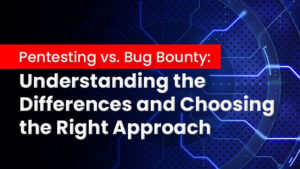Introduction
Due to the frequent interchangeability of the terms “cybersecurity” and “information security,” there is a great deal of confusion on whether there is a difference between the two ideas.
Although they have much in common, they also have different focuses and scopes. This article will cover detailed knowledge of Cybersecurity and Information Security and their differences.
What is Information Security?
Information Security, or “InfoSec,” is a broad field that includes techniques, procedures, guidelines, and technology to guard sensitive data from unauthorized access, disclosure, alteration, and destruction.
Its primary goal is to ensure information assets’ confidentiality, integrity, and availability (the CIA triad), regardless of their digital or physical form.
Here are some critical aspects of information security:
Confidentiality: This information security facet concerns restricting access to sensitive data to legitimate people or systems.
It involves access controls, encryption, and classification to safeguard data from unauthorized disclosure.
Integrity: Information must remain intact and unaltered to maintain its trustworthiness. Data integrity involves using checksums, digital signatures, and version control to detect and prevent unauthorized modifications.
Availability: Information should be available when needed by authorized users or systems. Availability is maintained through redundancy, fault tolerance, disaster recovery planning, and effective system monitoring.
Authentication: Verifying the identity of users and systems is crucial to information security. Authentication methods include passwords, biometrics, two-factor Authentication (2FA), and Multi-Factor Authentication (MFA).
Authorization: Once a user or system is authenticated, authorization determines what actions and resources they can access. Role-Based Access Control (RBAC) and permissions systems are standard methods for implementing authorization.
Data Encryption: Data in transit and at rest can be protected from unauthorized access using encryption.
Encryption algorithms and keys are used to secure sensitive information.
Network Security: Protecting the network infrastructure from threats is essential. This includes firewalls, intrusion detection/prevention systems (IDS/IPS), and network segmentation.
Endpoint Security: Securing individual devices like computers, smartphones, and tablets is critical. Key components include antivirus software, Endpoint Detection and Response (EDR) solutions, and regular patching.
Security Awareness Training: Training employees and users on security best practices helps mitigate risks associated with human error, social engineering, and phishing attacks.
Incident Response and Recovery: Organizations can respond to security issues effectively and quickly recover from them by developing and testing incident response strategies.
Information Security Benefits
Information security provides many benefits for individuals, organizations, and society. These benefits protect sensitive data and systems’ confidentiality, integrity, and availability. Here are some of the key advantages and benefits of information security:
Data Protection: Information security safeguards sensitive and confidential data, preventing unauthorized access, disclosure, or theft of valuable information, including personal data, financial records, and trade secrets.
Risk Mitigation: Effective information security practices help organizations identify, assess, and mitigate risks associated with cybersecurity threats and vulnerabilities, reducing the likelihood of security incidents and their potential impact.
Compliance and Legal Protection: Information security measures help organizations comply with industry-specific regulations (e.g., GDPR, HIPAA) and data protection laws, protecting them from legal consequences such as fines and lawsuits due to data breaches.
Preservation of Reputation: Maintaining strong information security safeguards an organization’s reputation and customer trust by preventing data breaches, security incidents, and public embarrassment.
Business Continuity: Information security includes disaster recovery and incident response planning, ensuring business continuity by minimizing downtime and disruptions caused by security incidents.
What is Cybersecurity?
Protecting computer systems, networks, software applications, and data from theft, damage, unauthorized access, and other cyber threats is known as cybersecurity. It includes a broad range of tools, procedures, methods, and guidelines intended to protect digital assets and guarantee the privacy, accuracy, and accessibility of data in the digital sphere.
Here are key components and aspects of cybersecurity:
Cyber Threats: Cybersecurity addresses a variety of threats, including malware (viruses, worms, Trojans), ransomware, phishing, hacking attempts, denial-of-service (DoS) attacks, and more. Threats can come from external actors (hackers, cybercriminals) and insiders (employees or contractors).
Information Security: Information security is a fundamental part of cybersecurity. It protects sensitive data, including personal, financial, intellectual, and proprietary information, from unauthorized access or disclosure.
Network Security: A key component of cybersecurity is preserving the integrity and confidentiality of data as it moves across networks. Network security measures include firewalls, intrusion detection/prevention systems, VPNs (Virtual Private Networks), and network segmentation.
Endpoint Security: Securing individual devices, such as computers, smartphones, and IoT (Internet of Things), is vital. Endpoint security solutions include antivirus software, anti-malware tools, and Endpoint Detection and Response (EDR) systems.
Identity and Access Management (IAM): IAM ensures that only approved systems and people can access particular resources. It involves the authentication (verifying user identity) and authorization (defining what users can do once authenticated).
Cryptography: Cybersecurity heavily relies on cryptographic methods like encryption and digital signatures. Digital signatures confirm the integrity and validity of messages and documents, while encryption safeguards data in use and at rest.
Security Awareness: Educating employees and users about security best practices, social engineering threats, and the importance of strong passwords is essential for mitigating risks associated with human error.
Cybersecurity Advantages
Protection of Sensitive Data: Personal information, financial records, intellectual property, and trade secrets are all protected from theft and unauthorized access by cybersecurity.
Preservation of Reputation: Effective cybersecurity practices help maintain an organization’s reputation and customer trust by preventing data breaches and security incidents that can lead to public embarrassment and financial losses.
Prevention of Financial Losses: Cybersecurity measures mitigate the risk of financial losses resulting from cyberattacks, such as ransomware, fraud, or theft, saving organizations significant amounts of money.
Compliance with Regulations: Cybersecurity helps organizations comply with industry-specific regulations and data protection laws (e.g., GDPR, HIPAA) by implementing necessary security controls and protecting sensitive data.
Business Continuity: Cybersecurity measures, including disaster recovery and incident response plans, ensure business continuity by reducing downtime and minimizing disruptions caused by security incidents.
Customer Trust: Demonstrating a commitment to cybersecurity enhances customer trust and loyalty. Customers are more likely to do business with organizations that protect their data.
Differences between Cybersecurity and Information Security
Cybersecurity and information security are closely related fields that share common goals but differ in scope and focus. Here are the critical differences between cybersecurity and information security:
Scope
- Cybersecurity: Primarily focuses on protecting digital assets, systems, networks, and data from cyber threats that originate in the digital realm, such as the internet or internal networks. It deals specifically with digital threats, attacks, and defenses.
- Information Security: A broader scope encompasses all forms of sensitive information, whether digital or physical. It includes policies, practices, and controls related to information protection throughout its entire lifecycle, including physical security, personnel security, and document handling.
Threat Landscape
- Cybersecurity: Primarily addresses threats related to the digital world, such as malware, hacking, phishing, denial-of-service attacks, and other online threats. It is concerned with protecting digital systems and networks.
- Information Security: Addresses a broader range of threats, including physical threats (e.g., theft of physical documents), human threats (e.g., social engineering), and procedural threats (e.g., mishandling of sensitive data). It is concerned with protecting information in all its forms.
Assets Protected
- Cybersecurity: Protects digital assets, including computers, servers, networks, and cloud resources. It focuses on safeguarding digital data and systems’ confidentiality, integrity, and availability.
- Information Security: Protects all assets, including digital data, physical documents, hardware, software, facilities, and intellectual property. It aims to ensure the security and integrity of information assets, regardless of their format.
Technological Emphasis
- Cybersecurity: Emphasizes technology-based solutions, such as firewalls, intrusion detection systems, encryption, antivirus software, and network monitoring tools. It relies heavily on digital defense mechanisms.
- Information Security: Encompasses technology but also emphasizes the role of policies, procedures, user training, and physical security measures in protecting information assets. It recognizes that information security goes beyond technology.
Focus on Networks
- Cybersecurity: Concentrates on network security, including securing data in transit, protecting network infrastructure, and defending against external cyber threats.
- Information Security: Encompasses network security but extends to broader areas, including physical security (e.g., secure file storage), access control, data classification, and compliance with data protection regulations.
Conclusion
While information security and cybersecurity attempt to protect sensitive data and assets, information security has a more all-encompassing strategy considering information protection’s physical and human aspects. In contrast, cybersecurity has a narrower focus on digital threats and defenses. Organizations frequently conflate these concepts in practice, but knowing the differences between them can aid in the creation of more thorough security plans.







